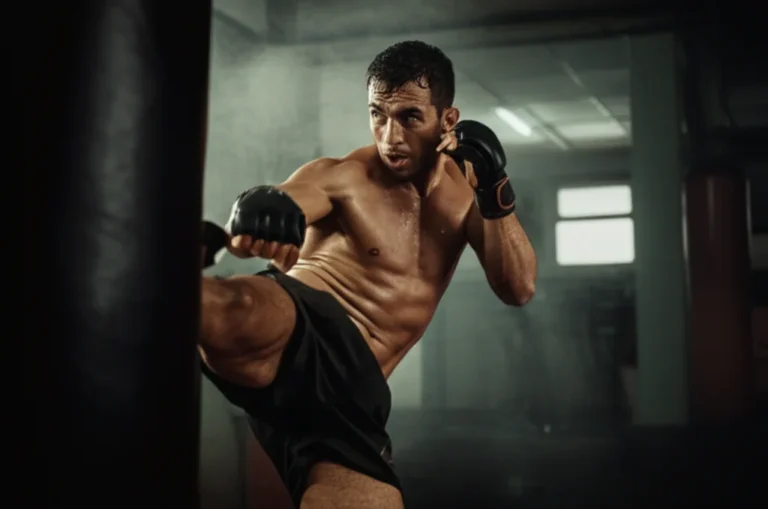Support our educational content for free when you purchase through links on our site. Learn more
What Is Mixed Martial Arts Called? 🥋 Unlocking 20+ Names (2025)
Ever wondered why mixed martial arts goes by so many names? From “cage fighting” to “ultimate fighting,” the terminology around MMA is as diverse and dynamic as the sport itself. At MMA Ninja™, we’ve seen firsthand how this combat sport has evolved from ancient contests to a global phenomenon with a rich vocabulary that reflects its history, culture, and philosophy. Stick around, because later we’ll reveal the surprising origins of some of MMA’s most popular nicknames and break down what each really means—plus, we’ll dive into how the sport’s identity continues to evolve in 2025 and beyond.
Did you know that the term “mixed martial arts” was only popularized in the early 1990s? Before that, it was often called “no-holds-barred” fighting, a phrase that conjured images of chaos and lawlessness. But today, MMA is a highly regulated, strategic, and respected sport with millions of fans worldwide. Curious to learn how these names came to be and what they say about the sport’s soul? Keep reading!
Key Takeaways
- Mixed Martial Arts (MMA) is the official and most widely recognized name, but the sport is also known as ultimate fighting, cage fighting, No-Holds-Barred (NHB), and Vale Tudo—each reflecting different eras and cultural influences.
- The term “mixed martial arts” was popularized in the 1990s to help legitimize and unify various fighting styles under a regulated sport.
- MMA’s rich history spans from ancient Greek Pankration to modern global promotions like the UFC, Bellator, and ONE Championship.
- The sport’s evolution includes the introduction of the Unified Rules of MMA, ensuring fighter safety and fair competition.
- Women’s MMA and amateur leagues have expanded the sport’s reach and inclusivity.
- For those interested in training or gearing up, we recommend checking out top MMA gloves, shin guards, and mouthguards available on Amazon and Venum.
👉 Shop MMA Gear:
- MMA Gloves: Amazon | Venum Official Website
- Shin Guards: Amazon | Venum Official Website
- Mouthguards: Amazon | Walmart
Table of Contents
- ⚡️ Quick Tips and Facts About Mixed Martial Arts
- 🥋 What Exactly Is Mixed Martial Arts? Defining MMA
- 📜 The Evolution of MMA: From Ancient Combat to Modern Sport
- 🚀 How MMA Exploded: Growth and Global Popularity
- 📅 Timeline of Major MMA Milestones and Events
- 🏆 Top MMA Organizations Shaping the Sport Today
- 📏 MMA Rules and Regulations: What’s Allowed and What’s Not
- 🥊 Common Martial Arts Disciplines in MMA
- 🧠 Basic MMA Strategies: How Fighters Win in the Cage
- 👩🎤 Women in MMA: Breaking Barriers and Making History
- 🥋 Amateur MMA: The Gateway to Professional Fighting
- 🛡️ Safety in MMA: Protecting Fighters Inside and Outside the Cage
- ⚖️ Legal Landscape of Professional MMA Around the World
- 💡 Common Misconceptions About MMA Debunked
- 🤼♂️ Training for MMA: What You Need to Know Before You Start
- 🎥 MMA in Pop Culture: Movies, TV, and Video Games
- 📚 Notes and Insider Tips From MMA Ninja™ Experts
- 🔗 Recommended Links for MMA Enthusiasts
- ❓ Frequently Asked Questions About Mixed Martial Arts
- 📖 Reference Links and Further Reading
- 🏁 Conclusion: What Is Mixed Martial Arts Really About?
Body
Alright, let’s get down to business! You’ve asked, “What is mixed martial arts called?” and we, the team at MMA Ninja™, are here to pull back the curtain. We live and breathe this stuff, and we’re going to give you the full 360-degree view. Forget the simple answers; we’re diving deep into the beautiful chaos that is MMA.
⚡️ Quick Tips and Facts About Mixed Martial Arts
Before we get into the nitty-gritty, here are some rapid-fire facts to get you warmed up:
- It’s Ancient! 🏛️ The concept of mixing fighting styles dates back to the ancient Greek sport of Pankration, which was introduced into the Olympic Games in 648 BCE. It was a brutal mix of wrestling and boxing with very few rules.
- Not Just One Name: While “Mixed Martial Arts” (MMA) is the official term, you’ll hear it called cage fighting, ultimate fighting, or the old-school term No-Holds-Barred (NHB).
- The UFC Revolution: The Ultimate Fighting Championship (UFC) didn’t invent MMA, but its first event in 1993 brought the concept to the mainstream in North America.
- It’s A Global Phenomenon: Once decried as a “brutal blood sport,” MMA is now one of the world’s fastest-growing spectator sports, sanctioned in all 50 U.S. states and many countries.
- Safety Has Evolved: Early events had minimal rules, like no biting or eye-gouging. Today, the sport is highly regulated by athletic commissions using the Unified Rules of Mixed Martial Arts.
🥋 What Exactly Is Mixed Martial Arts? Defining MMA
So, what’s the deal with all the different names? At its core, Mixed Martial Arts (MMA) is a full-contact combat sport that allows a wide variety of fighting techniques from a multitude of different martial arts to be used in competition. It incorporates both striking (like boxing and Muay Thai) and grappling (like wrestling and Brazilian Jiu-Jitsu), both on the feet and on the ground.
You might be wondering, what is a martial artist called who practices this incredible sport? We’ve got a whole article on that! Check out What Is a Martial Artist Called? 20+ Titles You Didn’t Know 🥋 (2025) for the full scoop.
Why So Many Names?
The variety of names often comes from branding and history:
- “Ultimate Fighting” / “UFC”: The UFC’s brand is so powerful that, for many, it has become synonymous with the sport itself, much like “Kleenex” for tissues. The term was part of their early marketing to find the “ultimate” fighting style.
- “Cage Fighting”: This is a descriptive nickname. While not all MMA fights happen in a cage (some are in a ring), the iconic octagon used by the UFC has made “the cage” a symbol of the sport.
- “No-Holds-Barred” (NHB): This was a term used for the early, less-regulated days of the sport. While it’s not accurate anymore due to the extensive rules, the name has stuck around in some circles.
- “Vale Tudo”: This Portuguese term, meaning “anything goes,” describes the brutal, early MMA-style events in Brazil that were a major precursor to the sport we see today.
📜 The Evolution of MMA: From Ancient Combat to Modern Sport
To truly understand MMA, you have to appreciate its rich and, frankly, wild history. This isn’t some new fad; it’s the modern expression of a question as old as humanity: which fighting style is the best? For more deep dives into the past, check out our MMA History section.
From Ancient Greece to Brazil
The journey starts with Pankration in the ancient Olympics, a sport where only biting and eye-gouging were off-limits. After the fall of the Roman Empire, this “anything goes” style of fighting resurfaced in 20th-century Brazil as Vale Tudo. This movement was famously championed by the Gracie family, who developed and showcased the effectiveness of their Brazilian Jiu-Jitsu (BJJ) in no-rules challenges.
The Influence of Bruce Lee
You can’t talk about the philosophy of mixing martial arts without mentioning the legendary Bruce Lee. In the 1960s and 70s, his philosophy of Jeet Kune Do (“The Way of the Intercepting Fist”) rejected rigid styles. Lee famously said, “The best fighter is not a boxer, karate or judo man. The best fighter is someone who can adapt to any style.” UFC President Dana White has even called Lee the “father of mixed martial arts.” This idea of taking what works from every discipline is the very soul of modern MMA and a core tenet of our Mixed Martial Arts Philosophy.
The Birth of the Modern Sport
In 1993, the Gracie family’s desire to prove BJJ’s dominance on a global stage led to the creation of the Ultimate Fighting Championship (UFC). The first tournament, UFC 1, saw the relatively small Royce Gracie submit one opponent after another, shocking the world and proving that a master grappler could defeat a larger, stronger striker. This event was the spark that lit the MMA fire in North America.
🚀 How MMA Exploded: Growth and Global Popularity
The journey from a controversial, “no-holds-barred” spectacle to a mainstream global sport was not a smooth one. In the beginning, MMA was banned in many places and condemned by politicians.
However, under the leadership of Dana White and the Fertitta brothers, who bought the UFC in 2001, the sport underwent a massive transformation. They worked with state athletic commissions to establish a unified set of rules, introduced weight classes, and implemented safety regulations.
The turning point for mainstream popularity was the reality TV show The Ultimate Fighter in 2005. The show’s dramatic finale, a now-legendary brawl between Forrest Griffin and Stephan Bonnar, captivated audiences and launched the UFC into the stratosphere. From there, the sport’s popularity has only grown, with pay-per-view numbers that rival boxing and a presence on major networks like ESPN. For the latest on the business side of the sport, keep an eye on our MMA Industry News category.
📅 Timeline of Major MMA Milestones and Events
Here’s a quick look at the key moments that shaped the sport we love today.
| Date/Era | Event | Significance |
|---|---|---|
| 648 BCE | Pankration is introduced to the Ancient Olympic Games. | The earliest known precursor to MMA, combining boxing and wrestling. |
| 1920s | The Gracie family develops Brazilian Jiu-Jitsu and Vale Tudo competitions begin in Brazil. | The birth of the ground-fighting style that would revolutionize combat sports. |
| 1960s-70s | Bruce Lee develops Jeet Kune Do. | Popularized the core philosophy of MMA: adapting and blending different styles. |
| 1985 | Shooto is formed in Japan. | One of the very first official MMA organizations, evolving from shoot wrestling. |
| Nov 1993 | The first Ultimate Fighting Championship (UFC 1) is held in Denver, Colorado. | Introduced MMA to a wide North American audience and showcased the dominance of BJJ. |
| 1997 | Pride Fighting Championships is founded in Japan. | Became the world’s largest MMA organization for a time, known for its spectacle and elite talent. |
| Nov 2000 | The first UFC event is held under the new Unified Rules of Mixed Martial Arts. | Marked the beginning of the modern, regulated era of the sport. |
| 2005 | The first season of The Ultimate Fighter airs. | The show’s success catapulted MMA into the mainstream. |
| 2007 | Zuffa (UFC’s parent company) acquires rival promotion Pride FC. | Consolidated the world’s top MMA talent under one roof. |
| 2012 | Ronda Rousey becomes the first female fighter signed to the UFC. | Paved the way for women’s divisions and created one of the sport’s biggest stars. |
| 2016 | The UFC is sold to WME-IMG for approximately $4 billion. | Solidified MMA’s status as a major player in the global sports industry. |
🏆 Top MMA Organizations Shaping the Sport Today
While the UFC is the undisputed king of the mountain, it’s not the only game in town. Several other promotions showcase world-class talent and offer different flavors of MMA action.
- Ultimate Fighting Championship (UFC): The global leader and home to the majority of the world’s top-ranked fighters. It’s the NFL of MMA.
- Bellator MMA: Long considered the #2 promotion in the U.S., Bellator features a mix of established veterans and rising stars.
- ONE Championship: Based in Singapore, ONE is a massive force in Asia. It promotes not just MMA, but also Muay Thai and kickboxing bouts, often in a ring instead of a cage.
- Professional Fighters League (PFL): The PFL stands out with its unique league format, where fighters compete in a regular season, playoffs, and a championship for a grand prize.
- Cage Warriors: A leading promotion in Europe, Cage Warriors is famous for being a breeding ground for future UFC stars, including Conor McGregor and Michael Bisping.
📏 MMA Rules and Regulations: What’s Allowed and What’s Not
Gone are the “no-holds-barred” days. Modern MMA is governed by the Unified Rules of Mixed Martial Arts, which were first established by the New Jersey State Athletic Control Board and are now the standard across North America and much of the world. These rules are all about ensuring fighter safety and fair competition.
The Basics
- Rounds: Fights consist of three or five 5-minute rounds, with a one-minute rest period in between. Championship fights are typically five rounds.
- Ways to Win: A fight can end in several ways:
- Knockout (KO): An opponent is rendered unconscious due to legal strikes.
- Technical Knockout (TKO): The referee stops the fight because a fighter can no longer intelligently defend themselves.
- Submission: A fighter taps out, either physically or verbally, due to a chokehold or joint lock.
- Decision: If the fight goes the distance, three judges score it round-by-round using the 10-point must system.
- The Cage/Ring: Fights take place in a fenced-in area (often an octagon) or a ring.
Weight Classes
To ensure fair fights, competitors are matched against opponents of a similar size. Here are the standard men’s weight classes:
| Weight Class | Upper Limit |
|---|---|
| Flyweight | 125 lbs |
| Bantamweight | 135 lbs |
| Featherweight | 145 lbs |
| Lightweight | 155 lbs |
| Welterweight | 170 lbs |
| Middleweight | 185 lbs |
| Light Heavyweight | 205 lbs |
| Heavyweight | 265 lbs |
Women’s divisions typically include Strawweight (115 lbs), Flyweight, Bantamweight, and Featherweight.
What’s Illegal? (The Fouls)
The Unified Rules list specific fouls that can result in a point deduction or disqualification. Here are some of the big ones:
- ❌ No headbutting.
- ❌ No eye-gouging of any kind.
- ❌ No biting or spitting at an opponent.
- ❌ No striking the groin, spine, or the back of the head.
- ❌ No kicking or kneeing the head of a grounded opponent (an opponent with more than just the soles of their feet on the mat).
- ❌ No stomping a grounded opponent.
- ❌ No holding the fence or an opponent’s shorts/gloves.
🥊 Common Martial Arts Disciplines in MMA
MMA is a beautiful melting pot of fighting styles. To succeed at the highest level, a fighter can’t be a one-trick pony. They must be well-versed in multiple disciplines. Here are the most common and effective bases for MMA fighters.
| Discipline | Primary Focus | What it Brings to MMA | Famous Practitioners |
|---|---|---|---|
| Wrestling | Grappling/Takedowns | The ability to dictate where the fight takes place. Excellent for takedowns, top control, and “ground-and-pound.” | Khabib Nurmagomedov, Daniel Cormier, Jon Jones |
| Brazilian Jiu-Jitsu (BJJ) | Grappling/Submissions | The art of finishing the fight on the ground. BJJ specialists are masters of joint locks and chokeholds. | Charles Oliveira, Demian Maia, Royce Gracie |
| Muay Thai | Striking | “The Art of Eight Limbs.” Utilizes punches, kicks, elbows, and knees. Devastating in the clinch. | Anderson Silva, José Aldo, Israel Adesanya |
| Boxing | Striking | The “sweet science” provides superior footwork, head movement, and powerful, precise punching combinations. | Conor McGregor, Petr Yan, Holly Holm |
| Judo | Grappling/Throws | Excellent for throws and trips from the clinch. Strong positional control on the ground. | Ronda Rousey, Fedor Emelianenko |
| Karate | Striking | Offers unique timing, footwork, and powerful, straight-line attacks from a distance. | Stephen “Wonderboy” Thompson, Lyoto Machida |
| Taekwondo | Striking | Known for its flashy and powerful kicking techniques, including spinning and jumping kicks. | Yair Rodriguez, Anthony Pettis |
🧠 Basic MMA Strategies: How Fighters Win in the Cage
Having all the techniques in the world doesn’t mean much without a strategy to apply them. Fighters and their teams develop specific game plans to exploit an opponent’s weaknesses. Need help crafting your own game plan? Our MMA Coaching section is a great place to start.
Here are the fundamental approaches you’ll see in the cage:
- Sprawl-and-Brawl: This is for the striker who wants to keep the fight standing. The goal is to use excellent takedown defense (the “sprawl”) to stuff a wrestler’s shots and then use superior boxing or Muay Thai to win on the feet.
- Ground-and-Pound: The classic wrestler’s strategy. Take the opponent down to the mat, establish a dominant position (like mount or side control), and rain down strikes until the referee stops the fight.
- Submission Seeking: The BJJ player’s domain. This strategy can involve pulling an opponent into their “guard” from the bottom or using takedowns to get the fight to the ground, where they can hunt for a fight-ending choke or joint lock.
- Clinch Fighting: This is the grueling, in-close battle against the cage. Fighters use this position to wear down opponents, land short strikes like knees and elbows, or set up takedowns and throws.
Ever wonder which strategy is the most effective? Well, that’s the million-dollar question, isn’t it? The truth is, the best strategy is the one that a fighter can execute perfectly against that specific night’s opponent.
👩🎤 Women in MMA: Breaking Barriers and Making History
It wasn’t long ago that the idea of women fighting in the UFC was dismissed. But thanks to a generation of pioneers, women’s mixed martial arts (WMMA) has exploded in popularity and is now a staple of major promotions worldwide.
The Pioneers and Stars
Fighters like Gina Carano and Cris Cyborg were early stars who proved there was a huge audience for WMMA. However, it was Ronda Rousey who truly shattered the glass ceiling. Her star power, charisma, and incredible run as the first-ever UFC Women’s Bantamweight Champion brought unprecedented attention to the sport.
Since then, a wave of incredible female athletes has taken the sport to new heights. Champions like Amanda Nunes (widely considered the greatest female fighter of all time), Valentina Shevchenko, Rose Namajunas, and Zhang Weili have headlined major events and proven that women can be just as technical, powerful, and exciting as their male counterparts. You can read more about these incredible athletes in our Fighter Profiles.
Promotions like Invicta FC, an all-female organization, have also been crucial in developing female talent and providing a platform for women to shine.
🥋 Amateur MMA: The Gateway to Professional Fighting
Before fighters make it to the bright lights of the UFC or Bellator, most of them cut their teeth in the amateur ranks. Amateur MMA provides a crucial training ground for athletes to gain experience in a safer, more controlled environment.
Governing bodies like the International Mixed Martial Arts Federation (IMMAF) work to standardize rules and promote safety at the amateur level. Key differences often include:
- Shorter rounds.
- Mandatory use of protective gear like shin guards.
- Restrictions on certain techniques (e.g., no elbows or knees to the head).
The goal of amateur MMA is development. It allows fighters to test their skills, learn how to handle the pressure of competition, and build a record before deciding to turn professional.
🛡️ Safety in MMA: Protecting Fighters Inside and Outside the Cage
Let’s be real: MMA is a full-contact combat sport, and injuries are a part of it. Common injuries include cuts, bruises, sprains, and fractures. However, the perception of MMA as a lawless bloodbath is outdated and inaccurate.
The Reality of the Risks
The most significant long-term health concern in any contact sport is head trauma and the risk of Chronic Traumatic Encephalopathy (CTE). This is a serious issue that the sport continues to study and address. As former UFC fighter Spencer Fisher, who was diagnosed with CTE, described it, “I’m just beat up, and it’s just gotten worse… the brain thing… is the biggest one.”
However, studies have shown that MMA may be safer in some respects than sports like boxing. A University of Alberta study found that while MMA fighters suffer more minor injuries, boxers are at a higher risk of severe head trauma. The blood you often see in MMA is typically from superficial cuts or a broken nose, which look worse than they are.
Built-in Safety Measures
Modern MMA has numerous safety protocols in place:
- Pre- and Post-Fight Medicals: Fighters undergo extensive medical screening to ensure they are fit to compete.
- Professional Referees and Doctors: A trained referee is in the cage with the sole purpose of protecting the fighters. They will stop a fight if a competitor is no longer intelligently defending themselves. Ringside doctors are also present to assess injuries.
- Regulation: Athletic commissions provide oversight and enforce the Unified Rules.
- Tapping Out: Unlike boxing, where a fighter might take a sustained beating for several rounds, a fighter in MMA can end the fight at any time by submitting or “tapping out.”
⚖️ Legal Landscape of Professional MMA Around the World
The fight for legalization was one of the biggest battles in MMA’s history. Today, professional MMA is sanctioned and regulated in all 50 U.S. states, with New York being the last to legalize the sport in 2016.
Globally, the picture is similar. Countries across the world have established athletic commissions to oversee the sport. Canada, for example, formally decriminalized MMA in 2013, giving provinces the power to regulate it. Even France, which long opposed the sport, officially legalized it in 2020. This global acceptance is a testament to how far MMA has come from its controversial beginnings.
💡 Common Misconceptions About MMA Debunked
Despite its popularity, some old myths about MMA just won’t die. Let’s clear a few things up.
| Myth | Reality |
|---|---|
| “There are no rules! It’s human cockfighting.” | Completely False. As we’ve covered, the sport is heavily regulated by the Unified Rules of Mixed Martial Arts, which includes a long list of fouls and safety measures. |
| “The fighters are just mindless brutes.” | Far from it. MMA is often called “human chess.” It requires incredible intelligence, strategy, discipline, and the ability to process information and make split-second decisions under extreme pressure. |
| “It’s more dangerous than boxing.” | It’s complicated, but not necessarily. While MMA has a higher rate of minor injuries (cuts, bruises), some studies suggest boxing carries a greater risk of severe brain trauma because fighters can absorb more headshots over a longer period without a way to end the fight on the ground. |
| “You have to be a huge, muscular person to do it.” | Nope! The existence of weight classes means anyone of any size can compete. Technique and skill consistently triumph over brute strength, as Royce Gracie proved at UFC 1. |
🤼♂️ Training for MMA: What You Need to Know Before You Start
Thinking about stepping into the gym? Awesome! Training in MMA is one of the most rewarding things you can do. It will push you physically and mentally, build confidence, and teach you incredible skills.
What to Expect
- It’s a Grind: Be prepared to work. A typical MMA gym will have classes focused on specific disciplines (BJJ, Muay Thai, wrestling) as well as general MMA classes that blend them.
- Start with the Basics: You won’t be sparring on day one. You’ll start by learning fundamental stances, footwork, basic punches, kicks, and grappling positions.
- Find a Good Gym: Look for a gym with experienced coaches who prioritize safety and a welcoming environment for beginners. Check their lineage—do the coaches have legitimate competition experience or have they trained successful fighters?
- Get the Right Gear: You don’t need everything at once, but you’ll eventually need some key items.
👉 Shop for MMA Gear on:
- MMA Gloves (4oz): Amazon | Walmart
- Boxing Gloves (16oz for sparring): Amazon | Walmart
- Shin Guards: Amazon | Venum Official Website
- Mouthguard: Amazon | Walmart
🎥 MMA in Pop Culture: Movies, TV, and Video Games
MMA’s raw intensity and compelling human drama make it a perfect subject for Hollywood. Its influence has spread far and wide in popular culture.
- Movies: Films like Warrior (2011) and Here Comes the Boom (2012) have brought the emotional and physical struggles of fighters to the big screen.
- TV Shows: Series like Kingdom and The Ultimate Fighter reality show have given audiences a deeper look into the lives and training of MMA athletes.
- Video Games: The EA Sports UFC series is a hugely popular franchise that allows fans to step into the octagon and compete as their favorite fighters.
The video embedded above, “What Is Mixed Martial Arts? | MMA Fighting”, is a great visual introduction to the core concepts of the sport.
💡 Notes and Insider Tips From MMA Ninja™ Experts
Here at MMA Ninja™, we’ve spent countless hours on the mats, in the cage, and coaching fighters. Here are a few final thoughts from our team:
- Respect is Everything: The flashy knockouts get the highlights, but the foundation of all martial arts is respect. Respect for your training partners, your coaches, your opponents, and the sport itself.
- There Are No Shortcuts: The only way to get better is to show up, be consistent, and put in the work. Leave your ego at the door. The mats don’t lie.
- It’s a Journey, Not a Destination: You will have good days and bad days. You will get tapped out. You will get tired. The key is to embrace the process of learning and improving, one day at a time. The journey of a martial artist never truly ends.
🔗 Recommended Links for MMA Enthusiasts
Want to dive even deeper? Here are some of the best resources out there for news, analysis, and community discussion.
- MMA Junkie: A top source for MMA news, interviews, and event coverage.
- Sherdog: Famous for its extensive fighter database (Fight Finder) and forums.
- ESPN MMA: The worldwide leader in sports provides excellent coverage and analysis.
- r/MMA on Reddit: A massive and active community for discussion, news, and memes.
❓ Frequently Asked Questions About Mixed Martial Arts
What does MMA stand for?
MMA stands for Mixed Martial Arts.
Is UFC the same as MMA?
No. MMA is the sport; the UFC (Ultimate Fighting Championship) is the world’s largest promotion (or league) for that sport. Think of it like the NFL and American football.
What is the goal of an MMA fight?
The goal is to defeat your opponent using a combination of legal striking and grappling techniques, resulting in a knockout, submission, or a decision victory from the judges.
Is MMA dangerous for beginners to learn?
Training at a reputable gym is very safe. Good coaches prioritize safety, and beginners start with fundamental drills, not hard sparring. The risk of injury in a controlled training environment is low.
Do you have to compete to train in MMA?
Absolutely not! The vast majority of people who train in MMA do it for fitness, self-defense, confidence, and the love of the sport, with no intention of ever competing.
📖 Reference Links and Further Reading
For this article, we consulted a variety of high-quality sources to give you the most comprehensive information possible.
- Wikipedia: Mixed martial arts
- UFC.com: Intro to MMA
- AdrenalineFC.com: DISABILITY? I’LL CALL IT A DIFFABILITY.
🏁 Conclusion: What Is Mixed Martial Arts Really About?
So, what is mixed martial arts called? Well, it’s called many things—MMA, ultimate fighting, cage fighting, Vale Tudo—but at its heart, it’s a dynamic, evolving sport that blends the best techniques from a myriad of martial arts disciplines. From ancient Pankration to modern UFC bouts, MMA represents the ultimate test of skill, strategy, and heart.
We’ve unraveled the mystery behind the names, traced the sport’s fascinating history, and explored the rules, disciplines, and strategies that make MMA so compelling. Whether you’re a casual fan, an aspiring fighter, or just curious, understanding the depth and complexity of MMA enriches your appreciation of the sport.
The journey of MMA is far from over. It continues to grow, evolve, and inspire, breaking barriers—whether it’s women making history in the cage or athletes overcoming disabilities and redefining what it means to be a martial artist. So next time someone asks, “What is mixed martial arts called?” you can confidently say: it’s the world’s most exciting, multifaceted, and inclusive combat sport.
🔗 Recommended Links for MMA Enthusiasts & Shopping
Ready to dive deeper or gear up? Here are some top picks and resources:
Gear & Equipment:
-
MMA Gloves:
Amazon | Walmart | Venum Official Website -
Shin Guards:
Amazon | Venum Official Website
Books to Expand Your MMA Knowledge:
-
The Fighter’s Mind: Inside the Mental Game by Sam Sheridan
Amazon -
Mixed Martial Arts: The Book of Knowledge by B.J. Penn and Glen Cordoza
Amazon -
A Fighter’s Heart: One Man’s Journey Through the World of Fighting by Sam Sheridan
Amazon
❓ Frequently Asked Questions About Mixed Martial Arts
What are the different names for mixed martial arts?
Mixed martial arts is known by several names including MMA, ultimate fighting, cage fighting, No-Holds-Barred (NHB), and Vale Tudo (Portuguese for “anything goes”). These names reflect different eras, marketing strategies, and cultural contexts but all refer to the same core sport blending multiple fighting styles.
How did mixed martial arts get its name?
The term “mixed martial arts” was first popularized in a 1993 review of UFC 1 by television critic Howard Rosenberg. Prior to that, the sport was often called “ultimate fighting” or “no-holds-barred.” The name reflects the sport’s essence: a mix of martial arts disciplines competing under a unified rule set.
Is MMA the same as mixed martial arts?
Yes! MMA is simply the widely used abbreviation for Mixed Martial Arts. It’s the standard shorthand in media, promotions, and everyday conversation.
What is the history behind the term mixed martial arts?
The phrase “mixed martial arts” gained traction in the early 1990s as the sport sought legitimacy and a formal identity. Before that, events were often described as “no-holds-barred” or “ultimate fighting.” The term helped unify disparate fighting styles under one banner and paved the way for regulation and mainstream acceptance.
What are the common abbreviations for mixed martial arts?
The most common abbreviation is MMA. Other less formal terms include NHB (No-Holds-Barred) and UF (Ultimate Fighting), though these are less used today.
How is mixed martial arts defined in sports?
MMA is defined as a full-contact combat sport that allows a wide variety of fighting techniques from multiple martial arts disciplines, including striking and grappling, both standing and on the ground. It is governed by a unified set of rules designed to ensure safety and fairness.
What distinguishes mixed martial arts from other combat sports?
Unlike single-discipline combat sports like boxing or wrestling, MMA combines multiple martial arts styles into one competition. Fighters must be proficient in striking, grappling, submissions, and defense across different ranges and positions. This versatility and the use of a cage or ring set MMA apart.
Additional FAQs
How do weight classes work in MMA?
Weight classes group fighters by size to ensure fair competition. For example, the UFC has divisions ranging from Flyweight (up to 125 lbs) to Heavyweight (up to 265 lbs). Women’s divisions include Strawweight (115 lbs) and Bantamweight (135 lbs), among others.
Are women allowed to compete in MMA?
Absolutely! Women have been competing in MMA professionally since the early 2000s, with major promotions like UFC and Invicta FC hosting female divisions. Stars like Ronda Rousey and Amanda Nunes have elevated women’s MMA to new heights.
What safety measures are in place in MMA?
MMA is highly regulated with mandatory medical checks, referees trained to stop fights to protect fighters, and strict rules banning dangerous techniques. Fighters wear gloves, and amateur competitions often require additional protective gear.
Can anyone train in MMA, or do you have to compete?
Anyone can train MMA for fitness, self-defense, or fun without ever competing. Many gyms welcome beginners and focus on skill development and conditioning.
📖 Reference Links and Further Reading
- Wikipedia: Mixed martial arts
- UFC Official Site: Intro to MMA
- International Mixed Martial Arts Federation (IMMAF): immaf.org
- Bellator MMA: bellator.com
- ONE Championship: onefc.com
- Adrenaline FC: DISABILITY? I’LL CALL IT A DIFFABILITY.
- MMA Ninja™ Categories:







